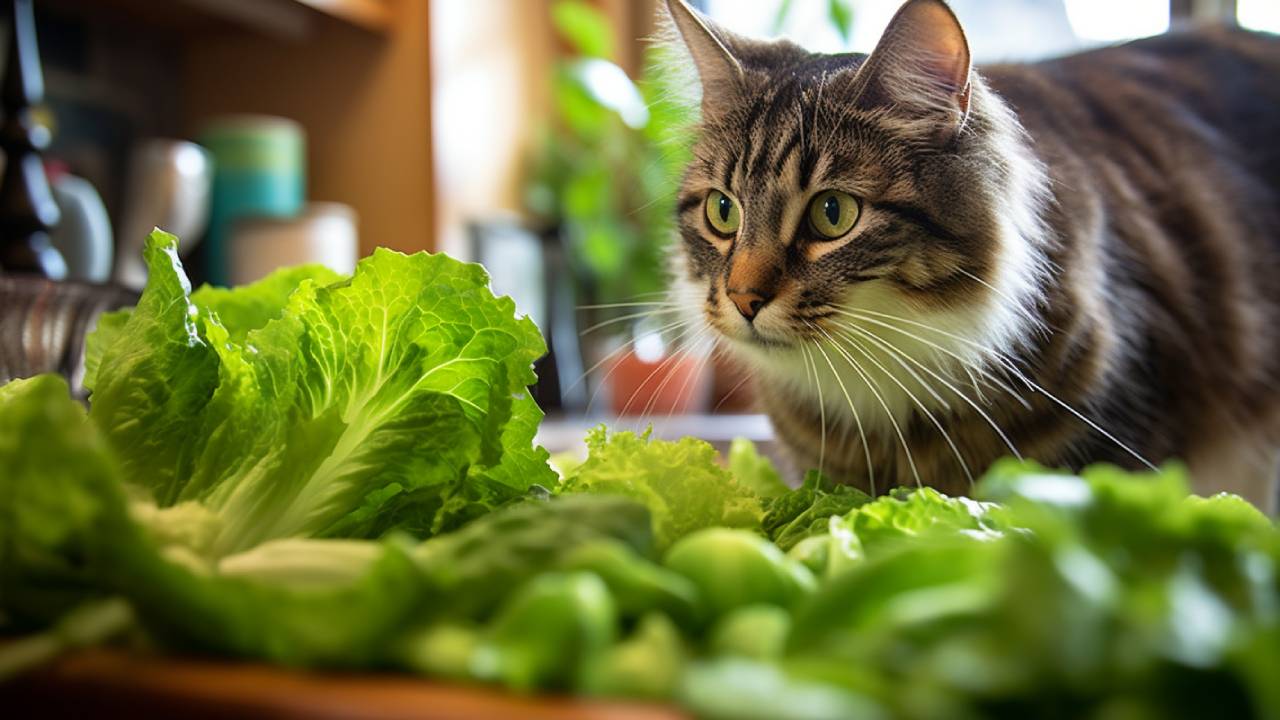Cats have a reputation for being picky eaters, but now and then, they might be curious, “Can cats eat kale?” It’s a valid question, especially if you love to share your veggies with your feline friend.
This article delves deep into kale and cats, exploring whether kale is safe for your furry companions, whether it should be served raw or cooked, and how much they can have. Let’s embark on this leafy green journey to ensure your kitten or cat enjoys a balanced and healthy diet.
Is Kale Safe for Cats?
The safety of kale for cats is a question many pet owners ponder. Kale is a leafy green vegetable packed with nutrients, making it a popular choice for health-conscious humans. However, cats have different dietary needs and digestive systems. So, is kale safe for them?
The answer is generally yes, but in moderation. Kale can be a healthy addition to your cat’s diet when offered as an occasional treat. It contains vitamins A and K and essential minerals like calcium and potassium.
However, it’s important to remember that cats are obligate carnivores, meaning their primary source of nutrition should come from animal-based protein.
Feeding your cat kale should be different from their regular cat food. Instead, consider it an occasional snack or a small addition to their diet.
Raw or Cooked Kale for Cats?
Now that we’ve established that cats can eat kale, the next question is whether it should be served raw or cooked. While kale is generally safe for cats in small amounts, opting for cooked kale over raw is best.
Raw kale can be tough to digest for cats due to its fibrous nature. The tough fibers can be stiff on their digestive system, potentially leading to gastrointestinal discomfort or upset. Cooking kale softens these fibers and makes it easier for your cat to digest.
Before serving kale to your cat, ensure it is thoroughly cooked and free from added seasonings or spices. Plain, steamed kale is the safest option. Avoid adding salt, garlic, onions, or other seasonings that can harm your feline friend.
How Safe Is It to Give Your Cat Kale?
When it comes to sharing kale with your cat, safety should be a top priority. Here are some tips to ensure your cat’s safety when introducing kale into their diet:
- Moderation: As mentioned earlier, kale should be given to your cat in moderation. Treat it as an occasional snack rather than a regular part of their diet.
- Thorough Cooking: If you choose to serve kale to your cat, ensure it is cooked until tender. This will make it easier for them to chew and digest.
- No Seasonings: Avoid adding seasonings, spices, or sauces to the kale. Cats have sensitive stomachs, and these additives can be harmful.
- Watch for Allergic Reactions: Keep an eye on your cat after they’ve eaten kale for the first time. If you notice any signs of allergies, such as vomiting, diarrhea, or excessive scratching, consult your veterinarian immediately.
- Consult Your Vet: Before making any significant changes to your cat’s diet, it’s always a good idea to consult your veterinarian. They can provide guidance based on your cat’s specific dietary needs and health.
How Much Kale Can a Cat Eat?
The amount of kale your cat can safely eat depends on various factors, including size, age, and overall health. A small amount as an occasional treat should suffice. A teaspoon or two of cooked, plain kale should be enough.
Keep in mind that cats have individual preferences and tolerances. Some may enjoy the taste of kale, while others may not be interested at all. Constantly monitor your cat’s reactions and adjust their diet accordingly.

What Kind of Kale Can a Cat Eat?
Not all kale is created equal; certain types are more suitable for your feline friend.
- Curly Kale: Curly kale is one of the most common varieties of kale and is generally safe for cats to consume. Its curly leaves and vibrant green color make it easily recognizable. This type of kale is readily available in most grocery stores and is a suitable choice if you plan to share some with your cat.
- Lacinato Kale: Lacinato kale, also known as dinosaur kale or Tuscan kale, is another variety that can be offered to your cat. Its dark green, elongated leaves have a slightly different texture compared to curly kale but are still safe for your furry companion to eat.
When selecting kale for your cat, make sure to take the following precautions:
- Thorough Washing: Regardless of the kale variety, washing it thoroughly before serving it to your cat is crucial. This helps remove any potential contaminants, such as dirt or pesticides, that may be present on the leaves.
- Organic Kale: If you have the option, consider choosing organic kale for your cat. Organic produce is typically grown without harmful pesticides and chemicals, making it a safer choice for your pet. Organic kale is less likely to contain residues that could harm your cat’s health.
You now have your answer to all the curious cat owners out there. Sharing a bit of your kale with your kitten isn’t a no-no.
Always ensure Kale is given in moderation. And while it can be an exciting treat to introduce, always put your cat’s nutrition first. That protein-rich diet is what keeps them purring, after all!

FAQs
Can other leafy greens be given to cats like spinach or chard?
While kale is safe in moderation, not all greens suit cats. Always research each vegetable individually before offering it to your feline.
Are there signs to watch for if my cat reacts poorly to kale?
Yes. If your cat has diarrhea, vomiting, or shows signs of discomfort after consuming kale, it’s best to avoid giving it in the future.
Can I give my cat kale juice or smoothies?
It’s best to offer kale in its natural form. Juices or smoothies might contain other ingredients not suitable for cats.
What about organic kale – is it better for my cat?
Organic kale reduces the risk of pesticide exposure, but it’s always essential to wash all vegetables thoroughly before offering them to pets.
Is there a difference in nutritional value for cats between cooked and raw kale?
Cats are obligate carnivores, so they won’t benefit from kale nutritionally as humans do. The main difference between cooked and raw is digestibility.
If my cat doesn’t like kale, are there other safe veggies I can try?
Certainly! Some cats enjoy carrots, zucchini, or broccoli. As always, introduce new food in moderation and monitor for adverse reactions.
Are there cat treats available that incorporate kale or other greens?
Yes, some commercial cat treats incorporate greens for added nutrition or fiber. Ensure they’re free of harmful additives and are given in moderation.







tried sneaking some greens into their cat’s diet? 🌿
My Siamese cat, Oliver, absolutely loves kale! I started adding tiny bits to his meals, and he gobbles it up. Such a relief to know it’s safe for him. Thanks for breaking down the do’s and don’ts!
Kale is a superfood for us humans, but what about our feline friends? My cat, Mittens, is always curious about what I’m eating. Any kale fans among the cats out there? 🌿😺